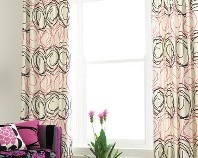All the Tribal Rage - Holst + Lee Color Block Jewelry
 April 1, 2012
April 1, 2012  Double Tiered Necklace, Holst + LeeThe latest fashion trend is color blocks – you can see it on the runway and you can see it on jewelry too. Shown above is the jewelry of Southern design duo Holst + Lee, based now in Brooklyn, NY. Like many creative thinkers, both Horst and Lee came to New York to pursue their dreams of fashion and fun, but not necessarily jewelry-making. That was just a happy accident.
Double Tiered Necklace, Holst + LeeThe latest fashion trend is color blocks – you can see it on the runway and you can see it on jewelry too. Shown above is the jewelry of Southern design duo Holst + Lee, based now in Brooklyn, NY. Like many creative thinkers, both Horst and Lee came to New York to pursue their dreams of fashion and fun, but not necessarily jewelry-making. That was just a happy accident.
 Dress by Gucci; dress by Nicole Miller, Spring 2012 CollectionsAs Holst and Lee tells it: they couldn’t find the appropriate accessories to wear with their outfits when they went out at night to party. They started with whatever they had at home – leftover beads, ropes, fabric - and refashioned them to eye-catching statements of jewelry. What started as a craft project soon caught the eyes of designers and stylists and morphed into a business of very original jewelry.
Dress by Gucci; dress by Nicole Miller, Spring 2012 CollectionsAs Holst and Lee tells it: they couldn’t find the appropriate accessories to wear with their outfits when they went out at night to party. They started with whatever they had at home – leftover beads, ropes, fabric - and refashioned them to eye-catching statements of jewelry. What started as a craft project soon caught the eyes of designers and stylists and morphed into a business of very original jewelry.
Both were attracted to bright colors and combined them to dramatic success – mixing the tangerines with the turquoise – as seen in the double-tiered necklace above, and the cobalts with the candy pinks in the necklace below. The result is a modern expression of tribal jewelry and a perfect complement to the bright colors of fashion this spring.
 (plate 10, courtesy of Holst + Lee)
(plate 10, courtesy of Holst + Lee)














